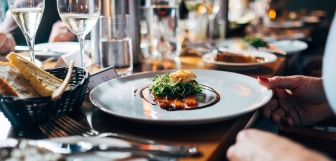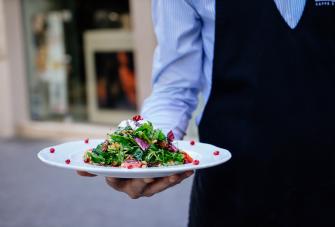How to Calculate Food Cost Percentage
When you sell food in a restaurant, having an overview of costs vs income is vital to ensuring your business’s survival. Many restaurants report that profit margins on food are thin [1]. Therefore, understanding your spending, and figuring out how to save on these costs as much as possible will help you maximize income.
Here, we’ll take you through everything you need to know to calculate your restaurant’s food cost percentage so you can continue to grow your business into the future.
Keeping costs down
To remain profitable, every business’s revenue must be higher than expenses. For a food service business, expenses may include labour, rent, utilities, and insurance, to name a few.
Reducing expenditure will mean that your overall profit margin will be higher. One significant cost you should aim to reduce is the price of ingredients, known as food cost percentage.
What is a food cost percentage?
A food cost percentage is the value of food costs against revenue, expressed as a percentage. It’s the amount of revenue that’s taken off when calculating how much profit you’ve made on a single dish. This is then extended to your whole menu.
How to calculate food cost percentage
Let’s say you have a salmon dish on your menu. That salmon dish sells on your menu for €15. The cost of the ingredients could be broken down like so:
- 1 salmon fillet: €2.30
- 10 oz mashed potatoes: €0.15
- 5 oz wilted spinach: €0.40
- 3 oz sauce: €0.30
- 10 oz quinoa: €0.30
So, the cost of the food for this dish would be about €3.45. That means that the food cost percentage for this dish would be: 3.45 / 15 = 0.23, or 23%.
You can use this formula and apply it to your larger-scale food costs, too.
To calculate your overall food cost percentages, you’ll need to have values for the following categories:
- Beginning inventory value: the value of ingredients purchased
- Purchases: the value of your additional inventory purchased after your initial inventory check
- Ending inventory: the value of the leftover inventory
- Total food sales: the value of your sales
To calculate the total food cost percentage for your restaurant, add the value of the beginning inventory and purchases, then subtract the ending inventory, and divide that total by the total food costs.
The profit margins on your salmon dish are pretty good, but how are the rest of the food costs performing in comparison? To use another example, your restaurant’s EPOS system may pull the following information from the database:
- Beginning inventory value: €10,000
- Purchases: €9,000
- Ending inventory value: €17,000
- Total food sales: €10,000
So, if we follow the formula above, we would get the following result:
(10,000 + 9,000) - 17,000 / 10,000 = 0.20, or 20%
The result means that you’re spending 20% of your revenue on ingredients. That’s a pretty good result!
What is the ideal food cost percentage?
The ideal food cost percentage depends on your business. An acceptable food cost percentage for one business would be completely unsustainable for another.
A restaurant’s food cost percentage must be measured against the business’s other costs. If you have very high food costs but extremely low labour costs and rent, you might be able to sell a high-quality product at a substantial mark-up.
Generally, a healthy food cost percentage would be anything below 35%. However, you should do what’s right for your business and not rely on catch-all averages.
You can calculate your ideal food cost percentage by dividing your total food costs by your total food sales.
Let’s say you have a total food cost of €3,000 and sales of €12,000. That means your ideal food cost percentage would be around 0.25, or 25%. It looks like that salmon dish is doing even better than your ideal food cost!
How to reduce food costs
But suppose your numbers aren’t quite as great as these. You might have a dish or two that’s costing you a pretty penny. Here are a few ways you can start to get those food costs down to start raking in bigger profits.
Find more affordable vendors
It could be that you’re paying top dollar for your produce when there are more economical options you haven’t discovered. Shop around to find the best vendors and prices for your ingredients. The smallest increase in cost on individual items can accumulate into massive costs in the long run, especially on items that are used frequently.
You also want to be careful not to compromise on quality. If your food has been living up to a particular standard and you suddenly start offering lower-quality food, your business may suffer.
Use less expensive ingredients
It might be that you’re using expensive ingredients when a more affordable alternative might work better for you.
For example, you might want to put a delicious fillet mignon on your menu. While this is a high-quality cut of meat, other, less costly options taste just as nice, and cost less money. A less expensive cut like a shin or a brisket can provide the starting point for amazing stews or burger fillings that burst with flavour.
You may also want to take advantage of more humble ingredients that are small on cost but big on flavour. Load up your dishes with cheaper starches like rice and potatoes, and use cheaper but delicious vegetables like carrots and cabbage to create wonderful meals.
Reduce portion sizes
Many restaurant owners want to give their customers good value for money, by serving larger-than-necessary portion sizes. They think that by giving them more, they’re giving their customers a better experience. While this can be true for some, it isn’t always the case — less can be more.
Focus on quality over quantity, and serve a portion that is generous enough to satisfy a customer, but not so much that they end up throwing food away. Reducing portion sizes will save money on overall food costs.
You’ll also want to track the effect this has on the number of dishes ordered. It could be that, by reducing portion size, you get fewer orders. But you might also get a bigger profit margin from what you end up selling.
Managing your ordering and inventory with an elite EPOS system
Managing your inventory and orders is vital to ensuring your profits remain high. You want to ensure you’re only ordering and storing what you need.
The Epos Now Restaurant EPOS is designed to help you manage and reduce food costs. With our EPOS, you can:
- Track inventory right down to the ingredient level
- Automate purchase orders and use low stock warning so you never run out of what you need
- Protect your bottom line with accurate stock control
- Minimize cash flow tied up in stock
- Manage inventory and track stock levels between multiple locations
Once you’ve taken your ordering and inventory game to the next level, you can start working on maximizing your profits with intelligent sales insights. Our EPOS system lets you:
- Visualize data and see trends with custom dashboards
- Access insights from any device and run your business on the go
- Determine market prices by analyzing winning and losing menu items
- Compare actual vs expected inventory to identify lost or stolen goods and reduce waste
- Simplify your accounting and taxes by syncing your reports with Sage, Xero, Quickbooks, and more




